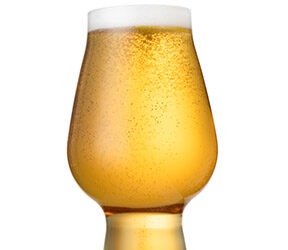Russian Imperial Stout: Tips from the Pros
Brewer: Eric Asebrook, Thirsty Dog Brewing Company in Dayton, OH
The concept of an imperial stout is one of balanced complexity. The nose is rich and fruity with hints of dark fruit (raisin, plum, currant, etc.) Upfront, a dark roasty almost coffee aroma should be evident. An alcohol aroma may be present but the best examples hide their strength.
The beer should have good body and taste like its aroma — rich, dark and chocolatey. The color should be pitch black and there should be a thick, brown head that forms. The best examples of imperial stout should have a balanced complexity, with all of the above attributes playing off each other without any overpowering the others.
The most important part of brewing an imperial stout is the ingredients. I use only English Maris Otter for a base malt. We also layer our toasty and biscuity malts as well as our Cara malts. One is good but two, or three different malts in the same family are better — think complexity! Yeast is critical and you should pitch a huge amount. When I brew an imperial stout I pitch double my standard pitching rate and pitch it on a half-sized batch. I cannot say it enough — pitch a ton of yeast!
Like your biscuit malts, layer the roasted malts as well. Up to 20% of the recipe is dark malt and you want complexity from these. Use different proportions of the dark malts to get up to the total percentage for the brew. Multiple dark malts are the way to go. Then, the most critical point is patience — these beers age remarkably well and patience will be rewarded. Aging should be at cellar temperature or cooler.
Quality malts in general are best but the dark roasted grains are the most important to an imperial stout. The dark grains give the beer its chocolate and coffee flavors while the rest of the grains contribute to the final flavor. My opinion is that no less than seven malts should be used so that the complexity will not be compromised.
The mash is pretty straightforward but there is a huge amount of grain. I like to use rice hulls so that there are no problems with the runoff because I collect very slowly. Mash as much as you can and if you need to compensate with amber liquid malt extract, feel free.
A mash of 90 minutes should be enough. Vorlauf for at least 20 minutes before collecting. The brewer should be trying to achieve the complexity in the mash. That is the reason for the 152–158 ºF (67–70 ºC) temperature range. It depends on how chewy you want it. The sign that it is working will be when you finally start the runoff, the first runnings should look like used motor oil — pitch black and thick.
The boil is pretty basic. It is up to the individual brewer, but in my experience 70 to 90 minutes is sufficient. As for boil-overs, they are always a concern — just pay attention and do not rush the boil and you should be fine.
I typically do two hop infusions in an imperial stout brewing session. One at about 60 minutes left in the boil and one at one minute left in the boil. The 60 minute addition should be between 2/3 and 4/5 of all the IBUs for the beer. The one minute addition should comprise the rest. In an imperial stout, I do not think that the hops are meant to stand out. They should play a supporting role to the dark malt flavors and aromas and keep the beer from being cloying.
With that said, I am not a fan of high alpha hops being used in an imperial stout. A neutral tasting bittering hop is my personal choice. American or German Northern Brewer are good choices as well as Horizon.
As for the flavor and aroma addition, my personal opinion is to use something that will not stick out too much. Northern Brewer and East Kent Golding are both good choices. Some brewers feel that the hops should “pop” but I am of the mind that the hops are there to support the beer, not dominate it. Fifty to 60 IBUs is a lot of hops, but in this beer it is for balance.
I can only recommend one yeast and that yeast is Wyeast 1028. I am familiar with this strain so I know what it will do. In my opinion it is the best yeast for the job. The best pitching temperature is between 66–72 ºF (19–22 ºC). Any ale strain should produce good results in this range. These beers are notoriously violent fermenters so hang on and enjoy a wild ride!
Brewer: Dan Rogers, Big Rock Chop House in Birmingham, MI
The flavor profile I look for in an imperial stout is a nice balance between coffee and chocolate. I like hop aroma, so, for me, dry-hopping is a must. The body will always be medium to high on a big beer like this, with the alcohol giving it a drying effect at the end. With 15% roasted barley in the grain bill, the SRM will push 200 easy. The color will be black and the head will have a buff, mocha appearance.
The key to a successful imperial stout is the grain bill. My rule of thumb is to use only roasted barley in stouts, no chocolate malt. Keep the mash thick — about 3.5 pounds per gallon (1.6 kg per 3.8 L) is good. This will allow you to sparge more and you want the first runnings no less than 25 ºPlato (1.000 SG). If you can step mash it is best, but if not shoot, for 151 ºF (66 ºC) and give it plenty of time for conversion.
Now comes the hard part . . . being patient! Run off and sparge very slowly. While you do this, start evaporating the wort in the brew kettle. Using two pots will make this easier and keep a fan blowing over the kettles. This will enable you to extract as much from the mash as possible. If you run off slowly you should have no problem with a stuck mash. Look for a final runnings of less than 6–8 ºPlato — you’ll know when you’re getting there because the runnings from the mash will lighten up considerably in color. Overshoot your target gravity 1 or 2 ºPlato (0.004–0.008 gravity points) and boil away to evaporate down to your target. When you reach 0.5 to 1.0 ºPlato (0.002–0.004 gravity points) over your target you can start the hop additions.
Kettle finings are a must. I recommend a fining agent that will also help clarify the beer later in fermentation. As far as yeast, alcohol tolerant ale strains are obviously best for this style. Nottingham and Whitbread strains work well and they floc out completely, leaving a jet-black color.
I add a lager yeast at the end of fermentation for aging purposes. Dry-hopping is optional and it only takes a small amount as the beer has a lot of alcohol and body.



